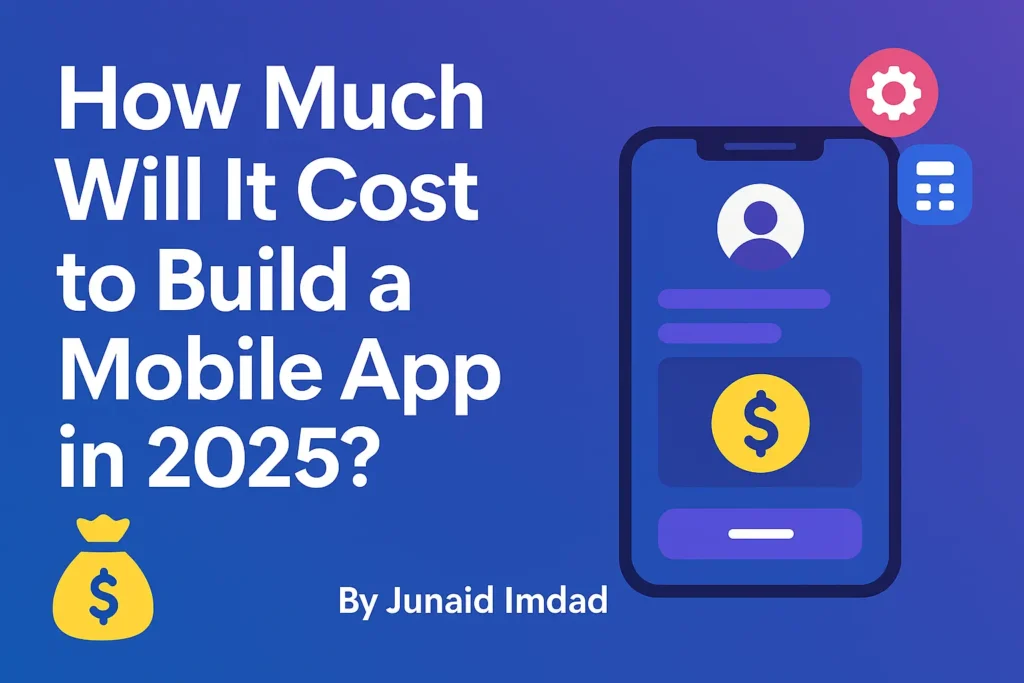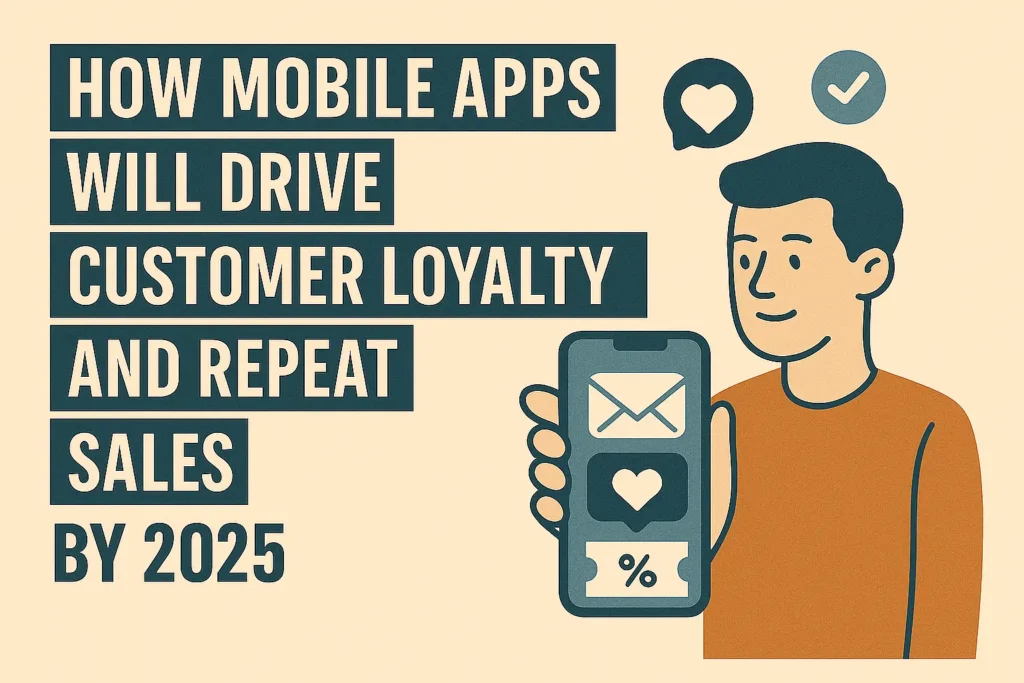digital-services

July 19,2025 • 14 min read
Successfully Launching Your First Mobile App in 2025: A Step-by-Step Guide

Successfully Launching Your First Mobile App in 2025: A Step-by-Step Guide
By Junaid Imdad, Blogger & Digital Experience Strategist
Launching your first mobile app is an exciting but often overwhelming journey. With over 7 million apps on Google Play and the Apple App Store combined, building a successful one is about more than just having a great idea. It requires clear planning, smart budgeting, knowing your audience, choosing the right platform, and staying on top of current trends.
This comprehensive guide walks you through every phase—from validating your idea to scaling your app after launch. Whether you’re a startup founder, entrepreneur, or business leader eyeing the mobile space, you’ll find clarity, direction, and actionable insights right here.
Why Launching Your First Mobile App in 2025 Is a Game-Changer
Launching your first mobile app in 2025 isn’t just a milestone—it’s a strategic move in a mobile-first digital era. With smartphone usage at an all-time high and consumer expectations rapidly evolving, building an app is no longer limited to big tech companies.
Whether you're a startup founder, small business owner, or solo entrepreneur, launching your first mobile app empowers you to connect with your audience on a personal level, offer seamless user experiences, and create brand loyalty through innovative features. It also unlocks new revenue streams, from in-app purchases to subscription models. As you embark on this exciting journey, understanding market trends, user needs, and the development process will be crucial for long-term success. If you're serious about growth in 2025, now is the perfect time to bring your app idea to life.
1. Define the Purpose and Problem Your App Solves
Before writing a single line of code or even thinking about hiring a developer, you need absolute clarity on the problem your app will solve. This may sound simple, but it’s where many first-time app creators go wrong. In 2025, the app stores are flooded with thousands of applications that look sleek but serve no real purpose—don’t let your app become one of them.
Think of the most successful apps you use every day. Whether it’s Uber for transportation, Notion for productivity, or Headspace for mindfulness, they all exist to solve a specific, frustrating, and frequently encountered problem. Your job as a first-time app builder is to identify a similar problem—one that is clear, relatable, and solvable with mobile technology.
Key Questions:
- What real-world problem does your app address?
- Who is experiencing this problem?
- How are users currently solving it, and how will your app be better?
Validation Tip:
Use tools like:
- Google Trends – Gauge search volume for related terms.
- App Annie / Sensor Tower – Analyze competitor apps and market potential.
- Reddit and Quora – Discover what frustrations users express in your niche.
Example: Building a fitness app for pregnant women? Browse reviews of apps like "Baby2Body" or “Ovia Pregnancy.” Note what users wish existed.
2. Identify Your Target Audience
One of the biggest traps first-time app creators fall into is believing they need to build an app “for everyone.” It feels like a safe bet—after all, the broader your audience, the more downloads you’ll get, right?
Wrong.
Trying to build an app for everyone is a fast track to building something no one truly needs. When you try to please every possible user, you end up diluting your product. Your features become too generic, your messaging too vague, and your user experience too scattered. The result? Your app gets lost in the sea of mediocrity.
Think of it this way: the most successful apps didn’t start by targeting the masses. They started by solving a very specific problem for a very specific audience. Instagram originally focused on photographers who wanted to share stylized photos. Airbnb catered to budget-conscious travelers looking for local stays. Slack was built for internal team communication in tech startups. Over time, these apps grew, evolved, and attracted wider audiences—but they didn’t start that way.
Build Detailed User Personas:
- Age, profession, and lifestyle
- Device preference (iOS vs. Android)
- Their challenges and goals
Persona Example: “Emily, a 29-year-old yoga instructor in Austin, needs a simple mobile app to track her prenatal clients’ sessions and progress.”
This affects everything: UI colors, font choices, notification frequency, monetization method, and more.
Dive deeper with: UI/UX Trends for 2025

3. Choose Between Native, Hybrid, or Web App
Each app development option—native, hybrid, or no-code/low-code—comes with its own set of advantages and trade-offs. The best choice ultimately depends on your budget, performance requirements, timeline, and technical skill level.
Native App
- Built for a single OS (iOS or Android)
- Best performance and access to device features
- Expensive and time-consuming
Hybrid App
- One codebase across platforms (e.g., React Native, Flutter)
- Cost-effective and faster to build
- May compromise some performance
Progressive Web App (PWA)
- Accessible via browsers
- Great for MVPs or informational tools
- Offline support, but limited native features
So, how do you decide? Start with your app’s purpose and long-term vision. If it’s a simple loyalty program for a local store, a no-code platform might be perfect. If you're building the next Uber or TikTok, native development is the way to go. And if you’re somewhere in between—say, launching a content platform or productivity tool—hybrid could strike the perfect balance.
Pro Tip: Start with hybrid or PWA for MVPs, then transition to native once traction grows.
4. Set a Realistic Budget
Mobile app development isn’t just about coding. While the lines of code may be the foundation of your app, the overall cost goes far beyond the development phase. Many first-time app creators make the mistake of budgeting solely for the build, only to realize too late that design, testing, deployment, maintenance, and marketing can often cost just as much—if not more—than the development itself.
Sample Budget Breakdown (for MVP):
- UI/UX Design: $5,000 – $15,000
- Development: $20,000 – $100,000+
- Marketing: $5,000 – $50,000
- Maintenance: $1,000 – $5,000/month
Use tools like Clutch or GoodFirms to find vetted development teams based on your needs and budget.
Pro Tip: Create a budget that includes post-launch costs for at least 6–12 months. The success of your first mobile app often hinges more on what you do after launch than during development.
Explore more: How Much Does It Cost to Build a Mobile App in 2025

5. Wireframing and Prototyping
Before your mobile app comes to life through code, it must be visualized, structured, and tested—this is where wireframes and prototypes play a crucial role in the development journey.
Wireframes are the visual blueprints of your app. Think of them as architectural sketches for your mobile application. They outline the basic layout of each screen, showcasing where elements like buttons, images, and menus will appear. These skeletal visuals help your design and development teams align on functionality and user flow before diving into design details. They’re low-fidelity, which means they’re not meant to look pretty—they’re meant to communicate structure, logic, and navigation.
Once your wireframes are approved, it’s time to breathe life into them with prototypes—interactive, clickable versions of your app. Prototypes simulate how the app will actually behave, allowing users, stakeholders, and testers to click through screens, test navigation, and provide early feedback. This stage is essential because it helps identify user experience issues, confusing flows, or design bottlenecks before expensive development begins.
Tools:
- Figma
- Adobe XD
- Sketch
Benefits:
- Test usability before development
- Get feedback early
- Minimize rework costs
Invite potential users to test your prototype. Capture pain points early before it costs money.
6. Hire the Right Team (or Build In-House)
When it comes to launching your first mobile app, hiring the right team isn't just a checkbox—it's a critical investment in your app's success. The people you choose to bring your idea to life will determine everything from the quality of the user experience to how smoothly the app performs under real-world conditions.
Options:
- Freelancers (Upwork, Toptal): Flexible, affordable for short-term
- Agencies: Offer end-to-end services
- In-House Team: Best for long-term vision and full control
Key Roles:
- Product Manager
- UI/UX Designer
- Mobile Developer (iOS/Android/Flutter)
- QA Tester
- Marketing Lead
Regardless of the route you take, look beyond just technical skills. The ideal developer or team should understand your business goals, your audience’s pain points, and have a genuine interest in building a great product—not just writing code. Soft skills like communication, adaptability, and problem-solving are just as important as proficiency in Swift, Kotlin, or React Native.
And don’t skip due diligence—ask for portfolios, check references, and conduct test tasks or paid trial periods if necessary. A wrong hire can result in missed deadlines, buggy code, and bloated costs. But the right hire? They can translate your vision into a beautiful, high-performing app that resonates with users and stands out in a crowded marketplace.
7. Build a Minimum Viable Product (MVP)
When launching your first mobile app, it's tempting to dream big and pack it full of every feature you’ve imagined. But hold on—before going full steam ahead, it’s crucial to focus on building your Minimum Viable Product (MVP). The MVP is not a cut-down or “lesser” version of your dream app—it’s a smart, focused version that solves the most important problem for your target audience, using the least amount of resources.
Focus On:
- 1–2 core features
- Basic but polished UI
- Sign-up/login
- Feedback mechanism
Example: A language-learning app MVP could offer 10 common phrases, a flashcard system, and voice playback—without community or gamification yet.
Goal: Launch quickly. Learn quickly. Improve quickly.
8. Test Thoroughly
When launching your first mobile app, testing is not an afterthought—it’s a mission-critical step. You’ve spent weeks, maybe months, designing, developing, and refining your app. But if it crashes, freezes, or delivers a poor user experience on launch day, users won’t stick around to forgive your mistakes. They’ll delete the app and likely never return. That’s why rigorous testing is essential to your success.
Testing Types:
- Functional – Do all features work?
- Usability – Is it easy to use?
- Performance – Does it lag or crash?
- Security – Are user data and payments secure?
- Beta Testing – Collect real-world feedback
Tools:
- TestFlight (iOS)
- Firebase App Distribution (Android)
Offer early users incentives (e.g., free lifetime access) in exchange for honest feedback.
9. Prepare for App Store Launch
Getting your app built is just one piece of the puzzle—getting it discovered is another challenge entirely. In 2025, App Store Optimization (ASO) is a vital part of launching your first mobile app successfully. Without a strong presence on the Apple App Store or Google Play Store, even the most useful app can become invisible.
Checklist:
- Compelling title and description
- High-res screenshots and preview video
- Keywords for ASO (App Store Optimization)
- Privacy policy and contact email
- In-app purchases or pricing set
Consider hiring an ASO specialist if you’re unfamiliar with mobile SEO.
10. Build Pre-Launch Buzz
One of the biggest mistakes first-time app creators make is waiting until development is complete before thinking about marketing. If you're serious about launching your first mobile app successfully, you need to start marketing long before your app is live in any store.
Pre-launch marketing is critical to generating awareness, building hype, and gathering early users. Think of it as planting the seeds so that your launch day doesn’t feel like shouting into the void. Here's how you can build momentum while development is still ongoing:
Build Early Awareness:
- Launch a landing page (with email capture)
- Tease features on social media
- Run countdowns or sneak peeks
- Submit to Product Hunt, BetaList, and Hacker News
Tools:
- Carrd or Webflow for pages
- Mailchimp for email collection
- Notion for public roadmap
Your goal: build an email waitlist, grow anticipation, and gather beta testers.
11. Launch and Monitor Metrics
Congratulations — you’ve made it through the development hurdles and successfully launched your first mobile app! But the journey doesn’t end at launch. In fact, post-launch performance tracking is where the real growth begins. Now it’s time to gather insights, measure key metrics, and make informed improvements to ensure your app continues to serve users effectively and grow sustainably.
Important Metrics:
- Daily/Monthly Active Users (DAU/MAU)
- Retention Rate (Day 1, 7, 30)
- Average Session Time
- Conversion Rates (downloads to in-app purchase)
- App Store Reviews
- Revenue (if monetized)
Tools:
- Mixpanel
- Firebase Analytics
- Amplitude
Run weekly reviews of analytics. Adjust strategy and features accordingly.
12. Gather Feedback & Iterate
When it comes to launching your first mobile app, it's important to understand that release day is not the finish line — it's the starting point of an ongoing evolution. The most successful apps are not perfect from day one. Instead, they’re built on a continuous improvement cycle that listens to user feedback, watches performance metrics, and adapts quickly.
Ways to Collect Feedback:
- In-app feedback widgets (Instabug, Usersnap)
- Push surveys (Typeform, Google Forms)
- Analyze reviews in App Store and Google Play
- Email users who churn for exit feedback
Treat feedback as gold. Release frequent updates to fix bugs and launch improvements based on actual needs.
13. Monetization Strategies
When launching your first mobile app, monetization is not just about choosing a pricing model — it’s about aligning how you make money with the expectations of your users and the true value your app provides. If there’s a mismatch, users will leave, churn will rise, and your growth will stall.
Options:
- In-app purchases (e.g., unlocking content)
- Subscriptions (e.g., monthly access to premium features)
- Ads (for free apps with high usage)
- Paid App Model (less common today)
- Freemium (most popular: free version with premium upsell)
- Affiliate and partnerships
Tip: Subscription models work best for productivity, fitness, and B2B apps.
14. Scale and Grow
Once your app goes live, your real work begins. Launching your first mobile app is a milestone—but now it's all about momentum. You need to shift gears from development to growth, user engagement, and long-term retention. Many apps lose users within days of installation, often due to poor onboarding, lack of updates, or unclear value. That’s why you must obsess over early user feedback, analyze behavior through tools like Firebase or Mixpanel, and identify what keeps people coming back.
Growth Tactics:
- Influencer partnerships
- Press coverage and guest blogging
- Launch new features monthly
- Use paid campaigns (Google Ads, Instagram, TikTok)
- Create content (YouTube walkthroughs, blog articles)
Retention Boosters:
- Loyalty programs
- Push notifications with real-time value
- In-app challenges or progress badges
- Personalized onboarding experiences
Learn more in: Customer Loyalty Through Apps in 2025

15. Avoid Common Mistakes First-Time Founders Make
- Building too many features at once
- Not testing enough
- Ignoring early user feedback
- Focusing only on launch, not retention
- Poor marketing budget planning
- Underestimating post-launch workload
Remember: Every great app was once version 1. Keep improving.
16. Final Thoughts: It’s a Marathon, Not a Sprint
Launching a mobile app in 2025 means navigating a competitive landscape, evolving user expectations, and rapid tech advancements.
Celebrate your wins: your first beta tester, your first review, your first hundred users. These are signs of traction and progress.
Stay agile, listen closely, and continue to build based on feedback. A mobile app can be the catalyst that elevates your brand, business, or career—but only if you continue to iterate.
Helpful Tools & Resources
- Build Smarter: Mobile App Features 2025 Checklist
- UI/UX Trends for 2025
- How Much Does It Cost to Build a Mobile App in 2025
- Customer Loyalty Through Mobile Apps
Ready to Build?
Need help designing or developing your first mobile app?
Connect with Dev IT City for:
- Strategic consultations
- Custom app development
- UI/UX design services
- Post-launch support and marketing
Let’s build something users will love—one screen at a time.
By Junaid Imdad, Blogger & Digital Experience Strategist
Dev IT City LTD. Details
User Profile
- Full name
- Dev IT City LTD.
- Email address
- info@devitcity.com
- Join Date
- 2024-07-28
- State
- City
- Pincode
- Address
- Follow us on Facebook
- Follow us on Twitter
- Website Name
- https://devitcity.com/
- Bio
- Established in 2022, Dev IT City Ltd. offers a comprehensive suite of digital solutions for businesses. We specialize in software development for mobile and web, along with various marketing services, including SEO, social media marketing, and graphic design. With a proven track record of success in the UAE, Malaysia, UK, USA, Philippines, Pakistan, India, Europe and other countries, Dev IT City Ltd. is your trusted partner for achieving digital success. We bridge the gap between marketing strategy and software development. Our team of passionate marketers and skilled developers work together to craft impactful digital experiences that drive results. We don't just talk success, we build it. Join us on this journey as we shape tomorrow's digital experiences, one breakthrough at a time.